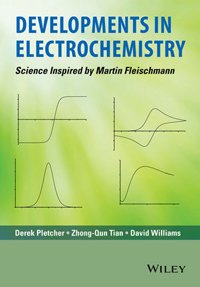Portrait of Martin Fleischmann by Winston August 2012
Infinite Energy Magazine Issue #117 highlights the new book Developments in Electrochemistry Science Inspired by Martin Fleischmann with the chapter on cold fusion written by veteran Navy scientist Melvin Miles and Michael McKubre, Director Energy Research Lab at SRI International, both of whom collaborated with Martin Fleischmann on cold fusion research for over a decade.
Read the original article here.
 New Book Honors Scientific Legacy of Fleischmann
New Book Honors Scientific Legacy of Fleischmann
by Christy L. Frazier
A new book honoring the scientific legacy of the late Prof. Martin Fleischmann has just been published by John Wiley & Sons. Developments in Electrochemistry: Science Inspired by Martin Fleischmann is edited by Derek Pletcher, Zhong-Qun Tian and David E. Williams, with 19 chapters (including the Introduction) about electrochemistry-related science written by electrochemists. Infinite Energy readers will be particularly interested in the chapter written by Melvin Miles and Michael McKubre, “Cold Fusion After a Quarter-Century: The Pd/D System.” Miles notes that he was picked as the cold fusion author and asked McKubre to assist him. He said he may have been chosen because he is “the only one other than Stan Pons who has written papers with Martin Fleischmann about calorimetry and the palladium-deuterium system.” Miles co-authored a number of papers during the last part of Fleischmann’s career.
Wiley’s website describes the book as “neither a biography nor a history” of Fleischmann’s contributions but rather a “series of critical reviews of topics in electrochemical science associated with Martin Fleischmann but remaining important today.” The chapters begin with an outline of Fleischmann’s contribution to the topic, followed by examples of research, established applications and prospects for future developments.
Editor Derek Pletcher worked with Fleischmann for 15 years at the University of Southampton. The book project was initiated because, “We believe Martin to have been a leading international scientist with very broad interests and a very warm personality and that we had benefitted greatly from our association with him (this includes some who were/are strongly anti cold fusion). We were therefore seeking a way to honor his memory and this became the book.”
The editors’ introduction, “Martin Fleischmann: The Scientist and the Person,” highlights great respect for Fleischmann’s approach to science and forward-thinking skill. They write: “Often his ideas were ahead of the ability of equipment to carry out the experiments, and it was only a few years later that the ideas came to fruition and it became possible to obtain high-quality experimental data.”
One of the editors, David Williams, was on the team at Harwell Atomic Energy Laboratory that purported to have negative results in replicating the cold fusion effect in 1989. Yet, in the Introduction the basic story of cold fusion is laid out and Fleischmann’s willingness to the end of his life in August 2012 to “defend the underlying concepts as well as his experiments” is recorded. They conclude, “It is inevitable and appropriate that this book contains a chapter on cold fusion that takes a positive view.”
McKubre appreciates the editors’ willingness to include what became a major part of Fleischmann’s scientific legacy. He said of the book, “This was a first class endeavor. I am very happy that it was done, and that cold fusion was included. At the end of Julian Schwinger’s life they rewrote his biography and reedited his bibliography to exclude mention of cold fusion. It is great to see that the electrochemistry community is not as narrowminded as the nuclear physics community seemed to be.”
The cold fusion chapter by Miles and McKubre focuses on “the multithreshold materials constraints that prevented easy reproducibility” of the Fleischmann-Pons (F-P) heat effect and the “brilliant, but largely not understood, implementation” of the F-P calorimeter. They note that some will believe that cold fusion “represents Martin Fleischmann’s greatest scientific failure.” They argue that the work may instead be one of the greatest contributions that Fleischmann made to science, noting that “few would have had the vision to see such a possibility, the courage to pursue it and the skill to test it” and that the F-P heat effect “is the sort of invention that only a man of Fleischmann’s knowledge, genius, confidence and courage was capable of making.”
Miles and McKubre conclude that “the future of Fleischmann’s dream must be practical, and therefore the heat effects must be cheaper, easier and of much larger scale and gain.” Future experiments are likely to utilize small-dimension materials including metals other than palladium in high-temperature.
Other chapters in the book include: A Critical Review of the Methods Available for Quantitative Evaluation of Electrode Kinetics at Stationary Macrodisk Electrodes; Electrocrystallization: Modeling and Its Application; Nucleation and Growth of New Phases on Electrode Surfaces; Organic Electrosynthesis; Electrochemical Engineering and Cell Design; Electrochemical Surface-Enhanced Raman Spectroscopy; Applications of Electrochemical Surface-Enhanced Raman Spectroscopy; In-Situ Scanning Probe Microscopies; In-Situ Infrared Spectroelectrochemical Studies of the Hydrogen Evolution Reaction; Electrochemical Noise: A Powerful General Tool; From Microelectrodes to Scanning Electrochemical Microscopy; In-Situ X-Ray Diffraction of Electrode Surface Structure; Tribocorrosion; Hard Science at Soft Interfaces; Electrochemistry in Unusual Fluids; Aspects of Light-Driven Water Splitting; Electrochemical Impedance Spectroscopy.
Developments in Electrochemistry: Science Inspired by Martin Fleischmann is available in hardcover ($115) and e-book format ($92.99) from the publisher at http://www.wiley.com/WileyCDA/WileyTitle/productCd-1118694430.html, and is also available on Amazon. According to editor Derek Pletcher, proceeds from sales will be used to fund a Biannual Fleischmann Lecture at the Annual Conference of the Electrochemistry Group of the Royal Society of Chemistry.
Related Links

